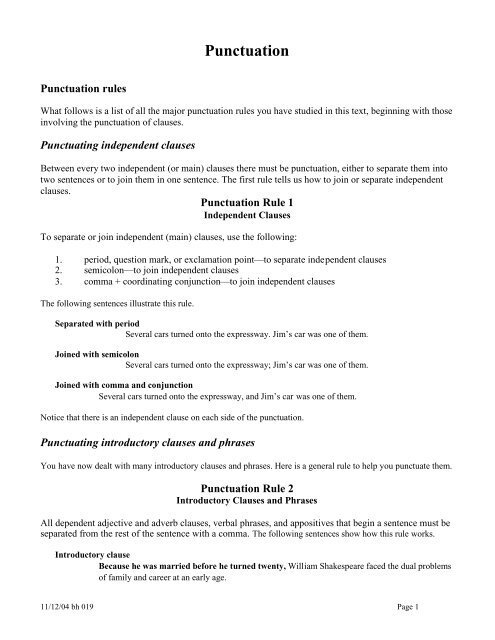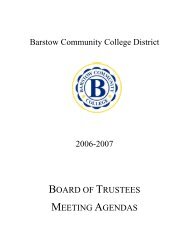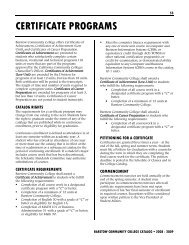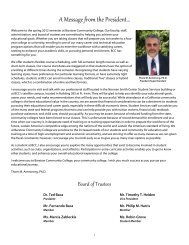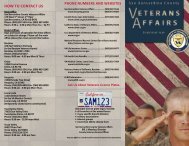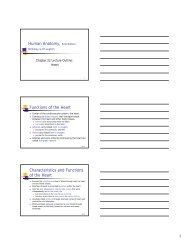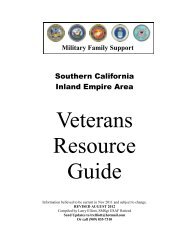019 Punctuation
019 Punctuation
019 Punctuation
You also want an ePaper? Increase the reach of your titles
YUMPU automatically turns print PDFs into web optimized ePapers that Google loves.
<strong>Punctuation</strong><br />
<strong>Punctuation</strong> rules<br />
What follows is a list of all the major punctuation rules you have studied in this text, beginning with those<br />
involving the punctuation of clauses.<br />
Punctuating independent clauses<br />
Between every two independent (or main) clauses there must be punctuation, either to separate them into<br />
two sentences or to join them in one sentence. The first rule tells us how to join or separate independent<br />
clauses.<br />
<strong>Punctuation</strong> Rule 1<br />
Independent Clauses<br />
To separate or join independent (main) clauses, use the following:<br />
1. period, question mark, or exclamation point—to separate independent clauses<br />
2. semicolon—to join independent clauses<br />
3. comma + coordinating conjunction—to join independent clauses<br />
The following sentences illustrate this rule.<br />
Separated with period<br />
Several cars turned onto the expressway. Jim’s car was one of them.<br />
Joined with semicolon<br />
Several cars turned onto the expressway; Jim’s car was one of them.<br />
Joined with comma and conjunction<br />
Several cars turned onto the expressway, and Jim’s car was one of them.<br />
Notice that there is an independent clause on each side of the punctuation.<br />
Punctuating introductory clauses and phrases<br />
You have now dealt with many introductory clauses and phrases. Here is a general rule to help you punctuate them.<br />
<strong>Punctuation</strong> Rule 2<br />
Introductory Clauses and Phrases<br />
All dependent adjective and adverb clauses, verbal phrases, and appositives that begin a sentence must be<br />
separated from the rest of the sentence with a comma. The following sentences show how this rule works.<br />
Introductory clause<br />
Because he was married before he turned twenty, William Shakespeare faced the dual problems<br />
of family and career at an early age.<br />
11/12/04 bh <strong>019</strong> Page 1
Introductory verbal phrase<br />
Married before he turned twenty, William Shakespeare faced the dual problems of family and<br />
career at an early age.<br />
Introductory appositive<br />
A married man before he turned twenty, William Shakespeare faced the dual problems of<br />
family and career at an early age.<br />
Punctuating “extra” clauses and phrases<br />
This rule deals with adjective and adverb clauses and phrases that contain extra information.<br />
<strong>Punctuation</strong> Rule 3<br />
Extra Adjective and Adverb Clauses and Phrases<br />
Adjective and adverb clauses, verbal phrases, and appositives that contain extra information must be<br />
separated from the rest of the sentence with commas.<br />
Necessary and extra adjective verbal phrases were discussed at length in Chapter 14 (pages 170—171), and<br />
adjective clauses were considered in Chapter 16 (pages 212—219). You may recall that extra adjective clauses or<br />
verbal phrases can be removed from a sentence without changing its meaning. They provide information that may<br />
be interesting and helpful but is not essential to the meaning of the sentence.<br />
Extra adjective clause<br />
Stanley, who was working in a factory at the time, wrote several short novels during the<br />
early 1970s.<br />
Extra verbal phrase<br />
Stanley, working in a factory at the time, wrote several short novels during the early 1970s.<br />
Appositives can also be identified as extra or necessary. Extra appositives are not essential to the meaning of the<br />
sentence.<br />
Extra appositive<br />
Stanley, a factory worker at the time, wrote several short novels during the early 1970s.<br />
Extra adverb clauses are usually introduced by tip-off words like.<br />
Extra adverb clause<br />
Stanley wrote several short novels during the early 1970s, although he was working in a<br />
factory at the time.<br />
Punctuating interrupters and lists<br />
The next three rules deal with interrupters, lists, and coordinate adjectives.<br />
11/12/04 bh <strong>019</strong> Page 2
<strong>Punctuation</strong> Rule 4<br />
Interrupters<br />
Separate interrupter words, phrases, and clauses from the rest of the sentence with commas. These<br />
interrupters include the following:<br />
1<br />
besides therefore by the way<br />
consequently as a result of course<br />
furthermore yes for example<br />
however no on the one hand<br />
moreover well on the other hand<br />
nevertheless oh<br />
meanwhile<br />
names and titles of people spoken to<br />
I believe<br />
I suppose<br />
not<br />
such as<br />
2<br />
3<br />
I think<br />
it seems to me<br />
according to<br />
but<br />
Keep in mind that interrupters can occur in three positions. The following sentences illustrate these patterns.<br />
Interrupter at beginning<br />
According to reporters, several citizens have mysteriously disappeared from the capital.<br />
Interrupter in middle<br />
Several citizens, according to reporters, have mysteriously disappeared from the capital.<br />
Interrupter at end<br />
Several citizens have mysteriously disappeared from the capital, according to reporters.<br />
Interrupters in Group 2 are not punctuated as interrupters when they appear at the beginning of the sentence.<br />
“I believe” as an interrupter<br />
Several citizens, I believe, have mysteriously disappeared from the capital.<br />
“I believe” at the beginning of a sentence<br />
I believe several citizens have mysteriously disappeared from the capital.<br />
<strong>Punctuation</strong> Rule 5<br />
Lists<br />
Separate with a comma each item in a list of three or more. Do not separate items in a list of two.<br />
This rule is easily applied, as the following examples show.<br />
11/12/04 bh <strong>019</strong> Page 3
List of two items<br />
An earthquake rocked the mountains of Peru and Chile.<br />
List of three items<br />
An earthquake rocked the mountains of Peru, Chile, and Bolivia.<br />
Note the comma used with and in the last example above.<br />
A variation of the list rule involves adjectives that could be joined by and but are not. These are called coordinate<br />
adjectives.<br />
<strong>Punctuation</strong> Rule 6<br />
Coordinate Adjectives<br />
Use a comma to join adjectives that could be joined by the coordinating conjunction and.<br />
Compare the following sentences.<br />
Office politics is a serious and dangerous game.<br />
Office politics is a serious, dangerous game.<br />
Note that both of the sentences above are correct.<br />
Punctuating direct quotations<br />
The rule below sums up the necessary steps.<br />
<strong>Punctuation</strong> Rule 7<br />
Direct Quotations<br />
1. Place quotation marks around the speaker’s exact words.<br />
2. Use commas to punctuate the he said statement, if any, as an interrupter.<br />
3. Capitalize the first letter of the speaker’s words, no matter where the first letter appears.<br />
4. Use a question mark instead of a comma or a period to show a question by the speaker or the writer.<br />
Use an exclamation point in the same way to indicate an exclamation.<br />
5. Use one set of quotation marks for the words of one speaker, unless those words are interrupted by<br />
the writer’s comments. Use new quotation marks to show a change of speakers.<br />
The following sentence illustrates the final effects of applying these steps.<br />
The sales manager said, “We should take advantage of each of these opportunities.”<br />
Notice that the comma and the period appear before the quotation marks.<br />
Punctuating Indirect Quotations<br />
Indirect quotations are usually sentences with noun clauses as objects, like the following:<br />
The manager said that she was tired. (Speaker’s exact words: I am tired.)<br />
The speaker’s exact words have been changed (this is what makes the quotation indirect). Notice that the<br />
noun clause containing the speaker’s words acts as the object of the verb. For this reason, indirect<br />
quotations like the one above receive no special punctuation.<br />
11/12/04 bh <strong>019</strong> Page 4
A variation of this pattern places the he said statement (or some version of it) in the middle of the<br />
quotation. There it acts like an interrupter. Compare the following.<br />
A company representative announced that no more workers would be laid off this year. (A<br />
version of he said at the beginning of the sentence.)<br />
No more workers, a company representative announced, would be laid off this year. (A version<br />
of he said as an interrupter.)<br />
Using the colon, dash, and hyphen<br />
This rule applies to three important, but less common, punctuation marks. They are the colon (:), the dash (—), and<br />
the hyphen (-).<br />
<strong>Punctuation</strong> Rule 8<br />
Colon, Dash, and Hyphen<br />
Use a colon or dash to attach a list or an explanation to the end of a sentence.<br />
Use dashes to add a list or an explanation in the middle of a sentence.<br />
Use a hyphen to form some compound words or to divide a word at the end of a line.<br />
The following sentences show how these marks are used.<br />
Colon before a list or explanation<br />
I took this job for two reasons: advancement and money.<br />
Dash before a list or explanation<br />
I took this job for two reasons—advancement and money.<br />
Dashes with an interrupting list<br />
Two reasons—advancement and money—made me take this job.<br />
Hyphen to form compound words<br />
She is a well-meaning but rather self-centered person.<br />
Hyphen to divide a word<br />
I took this job because I needed the challenge of new responsibilities.<br />
Using Apostrophes<br />
The apostrophe (‘) is used to make possessive adjectives. All nouns and most pronouns form possessive<br />
adjectives by using the apostrophe. The following rule will help your to spell these words correctly.<br />
<strong>Punctuation</strong> Rule 9<br />
Apostrophes in Possessive Adjectives<br />
To form possessive adjectives:<br />
1. Write the name of the owner or owners.<br />
2. Add an apostrophe to the end of the word that names the owner.<br />
3. Add an s after the apostrophe if the word that names the owner is either<br />
11/12/04 bh <strong>019</strong> Page 5
a. Singular, or<br />
b. Plural not ending in s.<br />
This rule is easy to apply and always produces the correct answer. The chief problem in spelling<br />
possessive adjectives is the temptation to add the apostrophe inside the name of the owner, not after it. Be<br />
sure to write the word that names the owner or owners first. Then add the apostrophe and, if necessary,<br />
the s.<br />
Using commas with conjunctions<br />
There are three kinds of conjunctions—coordinating conjunctions, conjunctive adverbs, and subordinating<br />
conjunctions. When we use all these conjunctions, we often have to use commas as well. Let us look at these three<br />
kinds of conjunctions and see what kind of punctuation should be used with them.<br />
Commas with coordinating conjunctions<br />
Coordinating conjunctions are conjunctions that join equals. They include and, or, but, nor, yet, for, and so. The<br />
following information summarizes the use of commas with coordinating conjunctions:<br />
1. Conjunction joining a list of two items in an independent clause—NO COMMAS<br />
2. Conjunction joining a list of three or more items in an independent clause—USE<br />
COMMAS<br />
3. Conjunctions joining independent clauses—USE COMMAS<br />
The most difficult situations to punctuate correctly involve conjunctions joining two verbs. Sentences where a<br />
conjunction joins two verbs in one independent clause are often confused with sentences where a conjunction joins<br />
two independent clauses.<br />
Conjunction joining two verbs in one independent clause<br />
Several men returned to the cabin and searched again for the old iron box.<br />
Conjunction joining two independent clauses<br />
Several men returned to the cabin, and they searched again for the old iron box.<br />
Commas with subordinating conjunctions<br />
Subordinating conjunctions make a clause (or a phrase) dependent on another clause. Clauses beginning with a<br />
subordinating conjunction (for example, when, while, since, although) can be noun or adverb clauses and are<br />
punctuated according to the rules for such clauses<br />
Commas with conjunctive adverbs<br />
The interrupter rule (Rule 4) shows how to punctuate conjunctive adverbs— words like however, nevertheless, and<br />
yet. When used in combination with a semicolon, these words can join independent clauses. In such cases, the<br />
conjunctive adverb is always followed by a comma.<br />
Cobwebs hung from the ceiling; however, the tiled floor was spotless.<br />
Notice that both the interrupter rule and the independent clauses rule (Rule 1) are followed. The semicolon joins the<br />
two clauses. The interrupter, appearing at the beginning of the second main clause, is punctuated with a comma<br />
according to the interrupter pattern.<br />
11/12/04 bh <strong>019</strong> Page 6
Breaking punctuation rules<br />
Like all rules, punctuation rules can, and sometimes should, be broken. Of course, we need to know them in order<br />
to break them properly; therefore, we still need to learn them.<br />
We should not break punctuation rules on a whim but only when another, more important principle is considered.<br />
The following principles are a guide to how and when you can break the rules you have learned.<br />
1. Do not over punctuate short sentences.<br />
2. Add commas wherever they are needed to make an unclear sentence clear.<br />
3. It is not necessary to separate simple interrupters that do not “feel” like interrupters.<br />
Take these principles into account when you punctuate. A complete discussion of each principle follows.<br />
Over punctuating short sentences<br />
To prevent short sentences from appearing over punctuated, you can leave out commas that normally appear<br />
1. after introductory clauses and phrases.<br />
2. with a conjunction between independent clauses.<br />
Adding commas for clarity<br />
Some sentences contain combinations of words that could be read in two ways. To keep readers from misreading a<br />
sentence, commas can be used to group phrases properly.<br />
Consider this example:<br />
In short, sentences must be easily read to be considered well written.<br />
If the comma after short were removed, the beginning of the sentence would read<br />
In short sentences…<br />
The comma after short prevents anyone from misunderstanding the sentence.<br />
Simple interrupters<br />
Sometimes a simple interrupter, like however or nevertheless, just doesn’t seem to interrupt the sentence. You may<br />
leave out the commas in such a sentence.<br />
She is nevertheless a good student.<br />
Placing commas before and after nevertheless would create awkward pauses where none are needed. Test sentences<br />
like this both ways before you decide on no punctuation. Remember that commas are needed with interrupters most<br />
of the time.<br />
11/12/04 bh <strong>019</strong> Page 7


